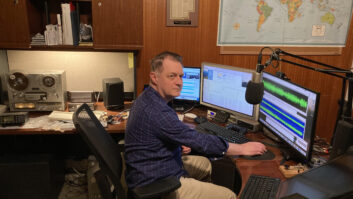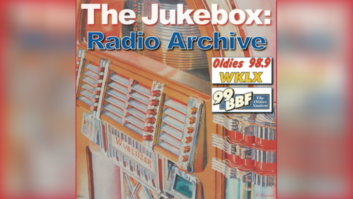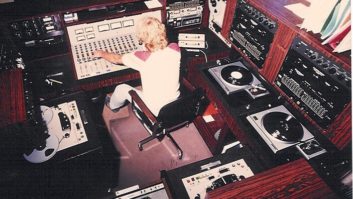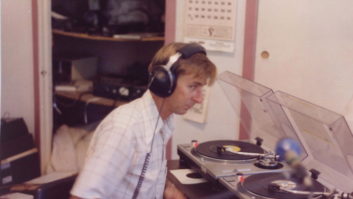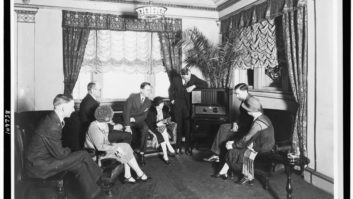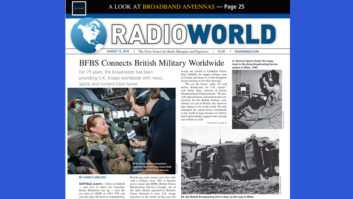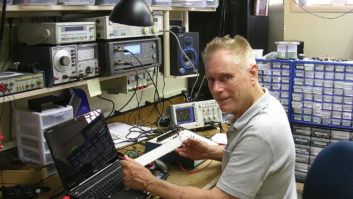I’m getting a lot of neat stories about what motivated readers to choose a career in broadcasting.
Curt Yengst, CSRE, engineer for WAWZF(M) in Zarephath, N.J., was motivated by a tape recorder. When he was about seven or eight years old and in the second grade in the mid-1970s, one of his friends had a gadget that fascinated Curt: a tape recorder.
Just the fact that his friend had his own tape recorder was pretty remarkable to Curt. By today’s standards, the thing would easily be regarded as primitive, but for a second-grader of the time, it was cutting-edge technology. It was a Panasonic, and it had a shiny silver and black case. He thought it was the coolest thing that his friend could record anything and play it back at will.
Curt thought, “I’ve got to get me one of these!” then realized, “There’s no way my parents will waste good money on something like that.”
Sometime after, Curt’s mother dragged him to the department store for another painfully boring shopping excursion. While his mother did her shopping, Curt wandered over to the electronics department.
There in a glass display case, he saw a veritable cornucopia of portable tape recorders, including the same exact model his friend had. At the time, Curt recollects it cost about $30, which to an eight-year-old in 1977 was roughly equivalent to the national debt.
On the other end of the display, the cheapest one in the case was a small green plastic tape recorder. It cost about $14. Even that was well out of Curt’s price range. Curt knew his parents weren’t going to go for it, so he decided then and there he would simply have to save up for it.
Curt remembers the night he counted his savings and discovered that he had finally saved enough to buy the tape recorder. There followed days of incessant badgering as he tried to get his mother to return to the store.
Finally, the blessed day arrived. Curt was about to part with every nickel he had to his name. He dragged his mother to the display case and tapped the glass between himself and his prize.
His mother looked at it with that look mothers get. You know the look. “Is that the one you want?”
“Uhh … yeah.”
“Are you sure?”
Curt thought, was she serious? Where had she been for the last several months? Curt was practically licking the glass, and she’s asking him if he’s sure it’s what he wants? The pregnant pause left him surprisingly hesitant. Mothers have that power. They can ask the simplest question and have you doing some serious soul searching over what should be a relatively simple thing. After all, it was only a tape recorder.
She then asked, “Which one does your friend have?” Curt pointed to the black and silver beauty at the other end of the case. “Well, what’s the matter with that one?” she persisted. Curt’s reaction was: Duh! It only costs way more than what he had. Curt replied, “I only have enough for this one.” What happened next left him speechless.
“Give us that one,” his mother said to the clerk, who was waiting patiently behind the case the whole time.
She was pointing to the black and silver beauty! Before Curt could react, his mom said, “Give me the money you have, and I’ll take care of the rest.” She took her wallet out, paid for the recorder, and even bought Curt a package of blank tapes!
Curt says he would bet a lot more than $30 that his mother had no idea that day where her “investment” would lead. That day began the journey of a lifetime, one Curt’s still on, and enjoying every minute of it.
That tape recorder is long gone, and others have taken its place, and have been replaced themselves; but he still remembers the feeling of recording anything that made noise. To this day, Curt still enjoys setting up a mic or two, recording, and then hitting rewind to hear what he captured. You’re never entirely sure what you’re going to get, but when it works out, it’s magic.
Of course, nowadays, it’s all digital. The “tape” is now a string of ones and zeroes, but the magic is still there. Curt ends his story by thanking his mom for the many years of magic the recorder provided, and for always being there.
***
In previous columns, we’ve promoted www.bird-x.com, which provides polycarbonate spikes that can be affixed to STL antenna dipoles to deter osprey or other roosting birds, as pictured in Fig. 1.

Bird Deterrent Technologies (www.bdtllc.com) has a different approach. Their Vulture Decoy provides almost instantaneous results, the company says. Birds get agitated and confused and then migrate to another property that presents a less threatening sight.
After hours of in-field, on-site evaluations, Bird Deterrent Technologies says its means tested and deployed the most realistic Vulture Bird Deterrent available.
Birds do not and will not congregate in an area where one of their own has been injured or killed. To an approaching bird, the decoy looks life-like (or lifeless), often creating a confused and agitated state. While sounding simplistic, these emotions are transferred bird-to-bird generating confusion among the approaching flock.
How can broadcasters use this device? The Vulture Bird Deterrent can be hung from a broadcast tower.
An article authored by the United States Department of Agriculture’s Animal and Plant Health Inspection Service (and highlighted on the company’s website) noted that suspended vulture carcasses provide a highly efficient method of controlling roosting bird activity on or around towers. Read it online at https://tinyurl.com/yaou2y2e.
Bird Deterrent Technologies’ method is a “simplistic, yet humane approach to deterring nuisance birds,” according to the company’s website (http://www.bdtllc.com/about). They note that towers that are free of birds are not only safer to service, but have a longer in-service life as a result of being free from acidic bird droppings, the company says.
***
Dale McCubbins is the production director for Christian Family Radio stations, headquartered in Bowling Green, Ky. Dale adds a comment to the June 20 Workbench discussion regarding flashlights.

Something Dale uses in the basement of the radio station is a COB-style “light switch” flashlight. Sold under several brand names, these compact flashlights combine batteries and bright LEDs in a light-switch type enclosure. I found one such model at Walgreens, and it’s shown in Fig. 2.
Rather than a sliding brightness switch, Dale’s version employs a “light switch” mounted on the face. Depending on the model, the flashlight can provide from 100 to 200 lumens. These are semi-portable — they have a magnet, hook-and-loop fastener or a screw-slot for hanging the light from a screw or hook.
In the basement of Ryan’s station, HVAC ductwork limits the light of the standard light sockets. Using the built-in magnet, Ryan attaches the lights directly to the HVAC ductwork.
Their portability makes these lights just as useful in the tool box as mounted on a wall. Ryan has even used these LED lamps at concert remotes after dark.
Although the product is available at hardware stores such as Ace, as well as big box stores, you can find these flashlights on Amazon. Enter “Jollytool” in the Amazon search field.
Contribute to Workbench. You’ll help fellow engineers and qualify for SBE recertification credit. Send Workbench tips and high-resolution photos to johnpbisset@gmail.com. Fax to (603) 472-4944.
Author John Bisset has spent 48 years in the broadcasting industry and is still learning. He handles western US Radio Sales for the Telos Alliance. He is SBE certified and is a past recipient of the SBE’s Educator of the Year Award.
